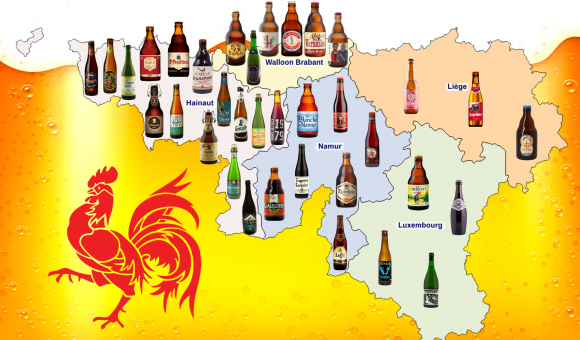
Belgium is one of the countries in the world with a deepest-rooted beer tradition and culture. Within its borders there are about 180 breweries that produce more than 1.150 different beers, and belgians consume over 7 million hectoliters of beer per year. Tourists who visit the country also widely consume and enjoy these beers, and as a result of this UNESCO recognized the belgian beer tradition as Intangible Heritage of Humanity in 2016.
A good number of these prestigious beers are produced in Wallonia, and in addition to strengthening the industrial and commercial sectors of the region, they have spread the good name of walloon products throughout the planet, causing many tourists to come to the region every year to visit its breweries and cafes. Since beer is an excellent excuse to visit Wallonia, we are going to review the places where the best walloon beers are produced.
Liège – Jupiler, Curtius
The province of Liège is crossed by the Meuse river, leaving picturesque scenes in the historic city of Liège and famous thermal baths in the town of Spa. The quality of its water is also reflected in the region's beers, where some of the most popular belgian references come from.
One of the most consumed pils in Belgium is Jupiler, a golden, light and refreshing beer that is widely sold in all corners of the country, being so important in society that it even sponsors the belgian national team and the football league.
Also based in Liège, and more specifically at the foot of the steps of Bueren mountain, is the local microbrewery Curtius. Its nearly 60 references, which include classic varieties and others as original as a beer made with authentic Liège waffles, can be enjoyed both in the brewery and in the attractive nearby restaurant.
Namur – Du Bocq
The province of Namur is home to the capital of the walloon region, which is located at the confluence of the Meuse and Sambre rivers. In the walloon festivals that are celebrated in the city of Namur in September, a fruit brandy with extensive local tradition called 'péquet' has a lot of prominence, but that does not mean that namurian beers are left behind.
The most important brewery in the region is Brasserie Du Bocq, established since 1858 in the tourist area of Condroz. Du Bocq brews the beers following traditional procedures, and in its extensive catalog there are such appreciated references as the wheat beer Blanche de Namur, the strong Tête de Mort or Te Deum, and the well-known seasonal winter beer Gauloise Christmas.
Hainaut – Dubuisson, Dupont, Cazeau, De Ranke, Blaugies, Brunehaut, Légendes
The province of Hainaut is home to a good number of interesting cities for visitors, such as its capital Mons or towns such as Charleroi, Tournai or Ath. Many of them have local breweries, so it can be said that Hainaut is the true beer epicenter of Wallonia.
Brasserie Dubuisson is located in the town of Leuze, and produces well-known beer brands such as Bush, an intense belgian strong golden ale that reaches an impressive figure of 12 degrees of alcohol, or Cuvée des Trolls, an elegant belgian blonde that is brewed with dried orange peel.
Not far from there, in the municipality of Tourpes, the famous Brasserie Dupont is based. This family brewery, founded in the 19th century, is a world leader thanks to its Saison Dupont, the best existing example of this type of rustic beer, very associated with the agricultural areas of Wallonia.
Another essential visit in Hainaut is the city of Tournai, one of the oldest in all of Belgium. There is the facilities of Brasserie de Cazeau, popular both for its Saison brewed with elderflowers and the Tournay beer series, which put a modern standpoint on classic belgian beer styles.
True beer fans would not miss a getaway to the municipality of Mouscron, very close to the french border. In addition to its spectacular neo-gothic town hall, the city is home to the Brouwerij De Ranke, a brewery run by and for beer lovers, in whose recipes hops and their bitterness have a special role, such as in the popular XX Bitter.
Saison lovers have an essential stop in Dour, where Brasserie de Blaugies is located. This small, family-owned and traditional brewery is specialized in farmhouse ales, producing excellent unfiltered varieties with loca ingredients, and has even brewed very successful collaborations with famous american breweries.
The town of Brunehaut gives its name to a brewery established in the area since 1890. Its beers have been widely awarded in international competitions, and are made with barley grown on a local farm. Among all of them, a large saga of gluten-free beers of different styles stands out, which also have an organic production certificate.
Finally, in the municipality of Ath is localted Brasserie des Légendes, a brewery with a very extensive catalog that includes references as well known to the general public as Quintine, Hercule, Goliath or La Corne. These latter beers are usually served in a peculiar horn-shaped glass, and are inspired by the tragic story of the Hanged Men's forest.
Walloon Brabant – Tilquin, Lefebvre, Waterloo
Walloon Brabant is the smallest of the provinces of Belgium, but in return it has a rich history and numerous tourist attractions that invite you to visit it, such as museums of art, natural history and archaeology, amusement and adventure parks and an extensive network of bike lanes that allow to organiz bicycle routes through all the region.
Just over 20 kilometers southwest of Brussels is the Senne river valley and the Pajottenland region, birthplace of lambic beers. This spontaneous fermentation brewing style is one of the oldest and most appreciated beer styles produced in Belgium. Only 20 breweries maintain the tradition today, and just one of them is located in the walloon region, specifically in Rebecq. Gueuzerie Tilquin is one of the most modern lambic breweries, but in just 15 years of work it has managed to produce world-famous lambics and gueuzes, aged in barrels and matured with different fruits.
Brasserie Lefebvre is also based in Rebecq, a brewery that has been managed by 6 generations of the same family since its foundation in 1876. Today a large part of its production, around 80%, is destined for export, and has such popular references as the strong golden ale Hopus, the witbier Blanche de Bruxelles, the Funky Brett fermented with brettanomyces yeast strains, or the striking Barbar beers brewed with honey.
The spirit of the famous Battle of Waterloo, in which Coalition troops defeated the Napoleonic army in 1815, is kept alive in a beer that bears its name. Waterloo is produced in a brewery located in Mont-St-Jean, a farm that housed an english field hospital during the battle, and recalls the beers that were offered to the soldiers to increase their strength and courage on the battlefield.
Luxembourg – Chouffe, Lupulus, Fântome
The province of Luxembourg occupies the southeastern corner of Wallonia, where the belgian, french and luxembourgish borders meet, and is home to numerous rivers and natural landscapes as spectacular as Belgian Lorraine or the Ardennes.
Precisely in the Ardennes forest, scene of some of the toughest battles of the two World Wars, the gnomes of Chouffe, one of the most international beers in Belgium, have their home. These friendly characters covered with an iconic red hat represent each of the brand's beers, telling their history and characteristics. The brewery's flagship is known simply as La Chouffe, and is a citrus and spicy belgian strong golden ale that just celebrated its 40th anniversary.
In this wooded region of the Luxembourg province it was also possible to encounter wolves like those that appear in the Brasserie Lupulus designs. This brewery is located in a 19th century farm in the town of Gouvy. In its beginning it produced beers for a nearby tavern, but since 2007 it created its own brand in which hops, a beer ingredient that shares its scientific name with the wolf, have a notable role.
And to conclude the tour of southeast Wallonia, you cannot miss a stop in Érezée to visit Brasserie Fântome, craft brewery founded in 1988. Its fame comes from the Saisons, which reinterpret the classic recipe by using different herbs, spices or fruit juices. These beers are so successful in countries like the United States or England that they are nothing easy to find in Belgium.
Abbey breweries – Val Dieu, St-Feuillien, Abbaye des Rocs, Maredsous, Leffe
The history and tradition of belgian beer would not have been the same without the existence of the abbeys, places of production during the Middle Ages of a drink that was much healthier than the water available at the time. The legacy of some of these traditional breweries is maintained in different abbeys throughout Wallonia.
Val-Dieu takes advantage of the numerous wells of excellent quality water found in Liège to produce great beers such as its quadrupel Grand Cru, the beer pride of this cistercian abbey. In Hainaut we can find Brasserie St-Feuillien, which takes up the tradition of an old abbey brewery destroyed during the French Revolution, and Abbaye des Rocs, whose monastic inspiration is limited to its name, but which is considered the first microbrewery in Belgium and a great dominator of strong and dark beers like the belgian strong dark ales.
But two of the best-known abbey breweries in the world are located in the province of Namur, not far from each other. The Abbaye de Maredsous reflects in its beers the values of patience, devotion and hospitality typical of the benedictine tradition, and brews references with a classic profile but highly appreciated by beer fans. It is a neighbor of the also namurian Abbaye de Leffe, a monastery where there is evidence of beer production since 1240, and which after becoming part of one of the largest brewing groups in the world, has managed to position its products in bars and stores all over the planet.
Trappist monasteries – Orval, Rochefort, Chimay
The elite of monastic beers are those known as trappist beers, brewed following very demanding criteria in a select group of 10 monasteries belonging to the trappist order. Five of these abbeys are belgian and three of them are located in Wallonia, making the region the current center of trappist beers.
Brasserie d'Orval owes its name to a legend rooted in a valley in Luxembourg, where a powerful lady lost a ring that was recovered by a trout, thus identifying it with a “valley of gold”. The brewery has been active since 1931 and only bottles a single reference, considered a living beer thanks to the evolution it experiences over time.
The Abbaye of Notre Abbaye Notre-Dame de Saint-Rémy is located in the province of Namur, and began producing Rochefort beers in 1595. It currently brews 3 classic and dark references, named with increasing numbers based on their intensity, as well as a tripel-style beer put on sale from 2020 to commemorate the centenary of the launch of the monastery's first strong beer intended for the public.
And in order to finalize this beer trip through Walloonia, in the province of Hainaut we can find the Abbaye de Scourmont, where Chimay beers have been brewed since 1862. Its five classic beers and the different special editions aged in barrels of various woods and liquors are excellent companions for the trappist cheeses that the monastery also produces, using milk from local farms and even the trappist beer itself in some of the varieties.

